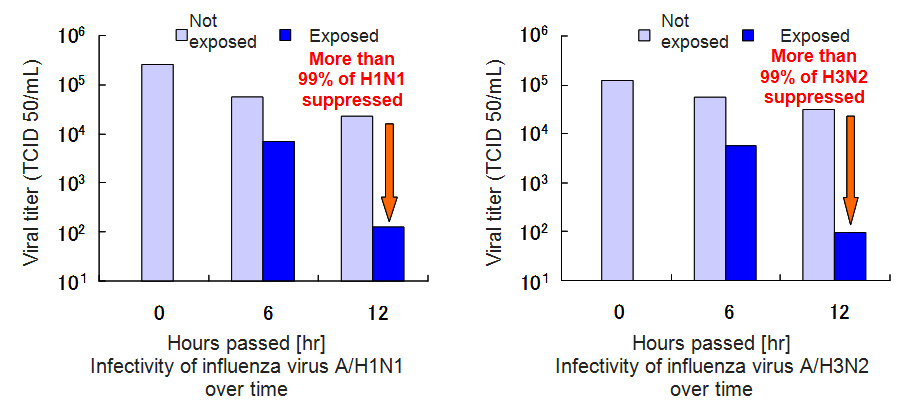Dec 8, 2011
Panasonic Ecology Systems Verifies That Electrostatic Atomized Water Particles Suppress 99% of Attached Type-A Influenza Viruses in a Large Space (30m3)
Kasugai,Aichi pref., Japan - Panasonic Ecology Systems Co., Ltd., Panasonic Corporation's affiliate, today announced that it has verified, jointly with Panasonic Electric Works Co., Ltd., and the Home Appliances Company of Panasonic Corporation, that "nanoe*1", electrostatic atomized water particles, which is generated by applying high voltage to water, suppress the infectivity of viruses that have attached themselves to the surface of objects in a space of approximately 30m3
Most cases of infection by the influenza virus occur either through the inhalation of droplets or through contact. Contact infections are mediated by a human hand that has touched an object contaminated by an infectious droplet. Viruses can survive a long time on the surface of objects in a living space. With cooperation from Wuhan University School of Medicine, China, Panasonic Ecology Systems verified that "nanoe" suppress 99% of attached influenza viruses in a test space of approximately 30m3, using two different subtypes of the type-A influenza virus.
The Company seeks to continue providing healthy and comfortable living space and contributing to the reduction of CO2 emissions, with its advanced products for improving indoor air quality (IAQ*2).
Method for Verification
Using two subtypes of the type-A influenza virus (H1N1 and H3N2), a comparative test was conducted between a space exposed to electrostatic atomized water particles (nanoe generator ON, fan ON), and a space not exposed to electrostatic atomized water particles (nanoe OFF, fan ON).
Verification Results
In twelve hours, more than 99% of the influenza viruses (A/H1N1 and A/H3N2 (type-A Hong Kong)) were suppressed.

*1. nano-sized electrostatic atomized water particles, which is generated by applying high voltage to water
*2. Quality of indoor air, including environmental factors that may affect human health
Verification Details
Type-A (H1N1) and Type-A Hong Kong (H3N2) influenza viruses were exposed to "nanoe", electrostatic atomized water particles. The effect of suppressing attached viruses by more than 99% was verified.
- Verifying laboratory: Institute of Virology, School of Medicine, Wuhan University School of Medicine, China
- Targeted viruses: Type-A influenza virus (H1N1 and H3N2)
- Targeted appliance: nanoe generator (with two nano-e devices)
- Methods for verification:
- Time exposed: 12 hours exposed to electrostatic atomized water particles (nanoe ON and fan ON) vs. no exposure (nanoe OFF and fan ON)
- Volume of the test space: 3.5 m x 3.5 m x 2.5 m (approx. 30m3)
- Preparation of the viral solution:
The test viral solution was prepared by multiplying viruses in the allantoic cavity of an embryonated egg, and diluting the resulting allantoic fluid (viral stock). - Preparation of the samples:
Three milliliters of the test viral solution was dropped onto each piece of sterile gauze (5 cm x 5 cm). The pieces of gauze were then hanged across the test room of approx. 30 cubic meters, using strings. - Exposure:
The samples, on which viruses has been attached, were set across the test room of approx. 30m3, which was exposed for over twelve hours to the nano-e generator. - Measurement of viral titer*3:
After over twelve hours of exposure, viruses was recovered from each sample, from which ten-fold serial dilutions were prepared, and infected by MDCK cells. Three days later, the viral titer (TCID 50*4) was calculated using the Reed-and-Muench method.
*3. Value that indicates the cell infectivity of virus
*4. Stands for "50% Median Tissue Culture Infectious Dose", which signifies the dilution rate at which a virus infects with a success rate of 50%
- Panasonic's web page introducing verified test items pertaining to "nanoe": http://panasonic.jp/nanoe/can/
